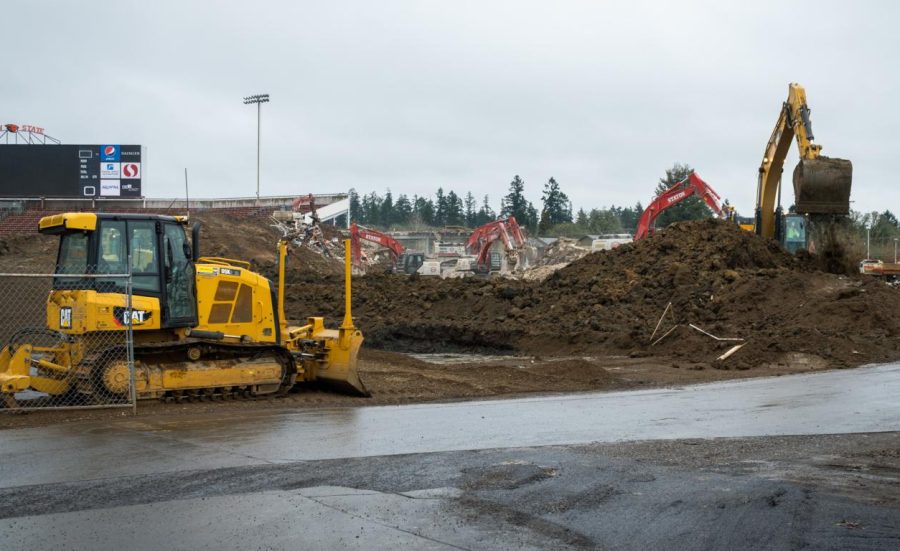Sunrise Corvallis protests construction, implosion of Reser Stadium
Construction workers use large machines on Jan. 9 to clean up debris left behind after the implosion of the west side of Reser Stadium that took place earlier that month. Since the project was announced, some students such as those involved in Sunrise Corvallis have been speaking out against the implosion and renovation of the stadium.
February 7, 2022
Reser Stadium continues to undergo construction after an implosion of its west side on Jan. 6, but some students in Sunrise Corvallis are protesting against this renovation.
According to Sunrise Corvallis protesters, the group is a youth-led movement fighting for systemic climate and environmental justice.
The protestors said they were protesting not just the implosion itself, but how the decisions were made and who made them.
“This right here was a decision that was made undemocratically by the board of trustees, many of which include fossil fuel barons essentially, people who are CEOs of Chevron, and other oil companies,” Sunrise Corvallis protesters said.
Reser Stadium’s construction was made possible by several large donations, including a $50 million anonymous donation and $68 million of university funds. These donations were made public in March 2021.
“So what we’re doing is completing Reser Stadium by completely redoing the west side,” said Steve Clark, vice president of University Relations and Marketing. “And this provides for one of the nation’s most modern, state of the art college football stadiums in the nation. It provides not only for best-in-show, best-in-class football stadium, but it also is going to provide for year-round activities around Reser Stadium.”
Improvements on the Oregon State University campus are nothing new to students. Buildings like Withycombe Hall and Graf Hall are also currently being renovated, yet these projects receive less attention from Sunrise Corvallis protestors than the Reser Stadium implosion.
“This is just a pattern of spending money on huge infrastructure projects, rather than renovating the existing infrastructure we already have,” Sunrise Corvallis protestors said.
Sunrise Corvallis protestors said they want more representation of students and for staff on the board of trustees to better represent the wishes of the people.
While Clark said he does not know if students were involved in planning the implosion or the actual construction of the stadium, he said student-athletes and student tour guides who work with the Enrollment Management office and the admissions office were likely part of the process of developing the new welcome center that will be in the surrounding area of the updated Reser Stadium.
“We think this is a really poor decision, we think it should not have been imploded, that the materials should have been taken down and recycled—that’s the normal procedure for projects like this,” protestors said.
According to Clark, the overall goal of renovating the stadium is to bring dynamic attention to the university.
“Certainly one of the goals of this project was that fan experience,” said Scott Barnes, vice president and director of intercollegiate athletics.
Regarding students and faculty who do not attend football games or are skeptical of the Reser renovation’s benefits, Clark said he believes sports coaching and athletics at the newly renovated Reser Stadium will build a stronger community for everyone at OSU.
“The new student welcome center is a destination where we can welcome prospective students and family to enroll in OSU and join OSU, and we think the opportunity to provide a welcome to more students will excite even more students to attend OSU,” Clark said.











































































































